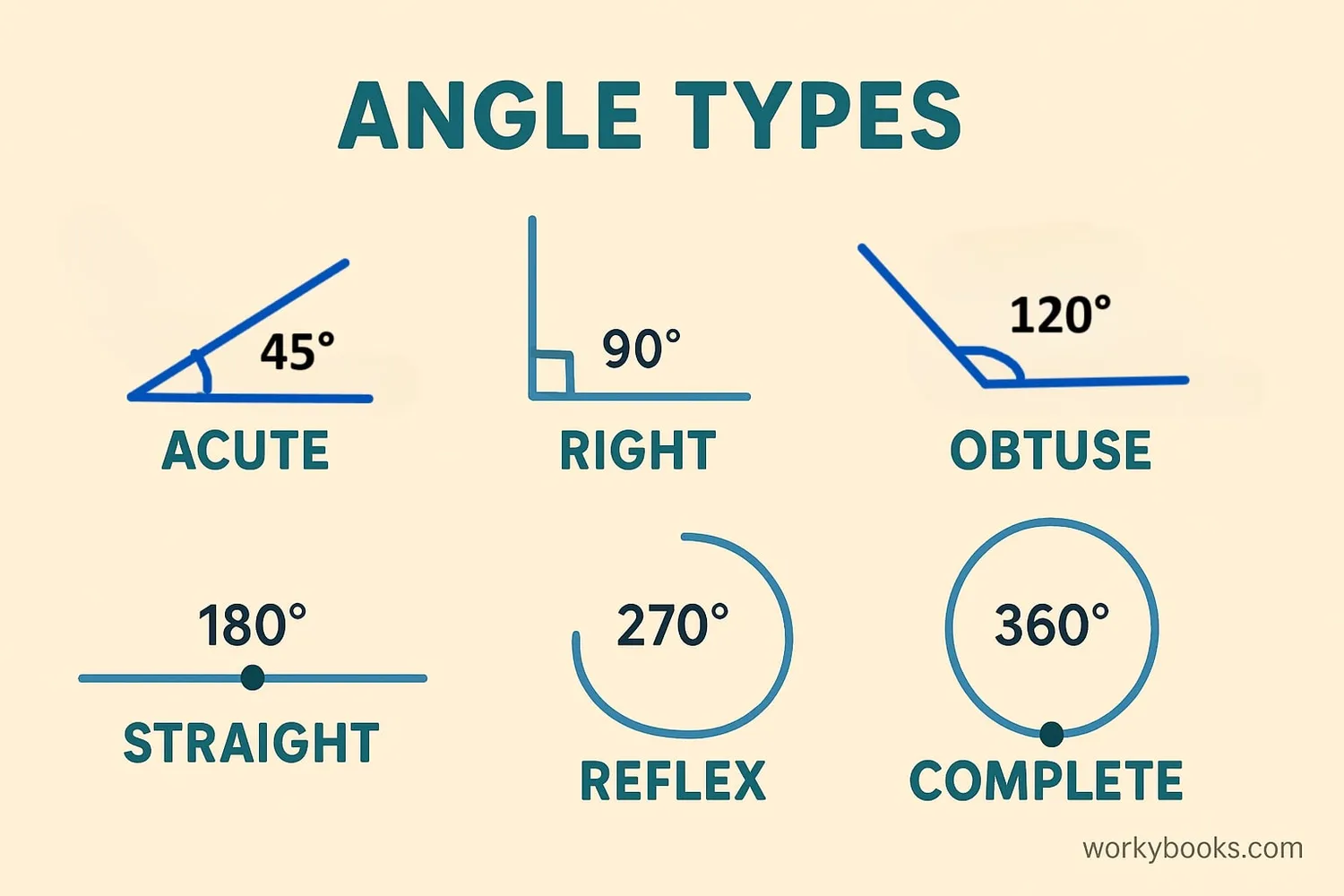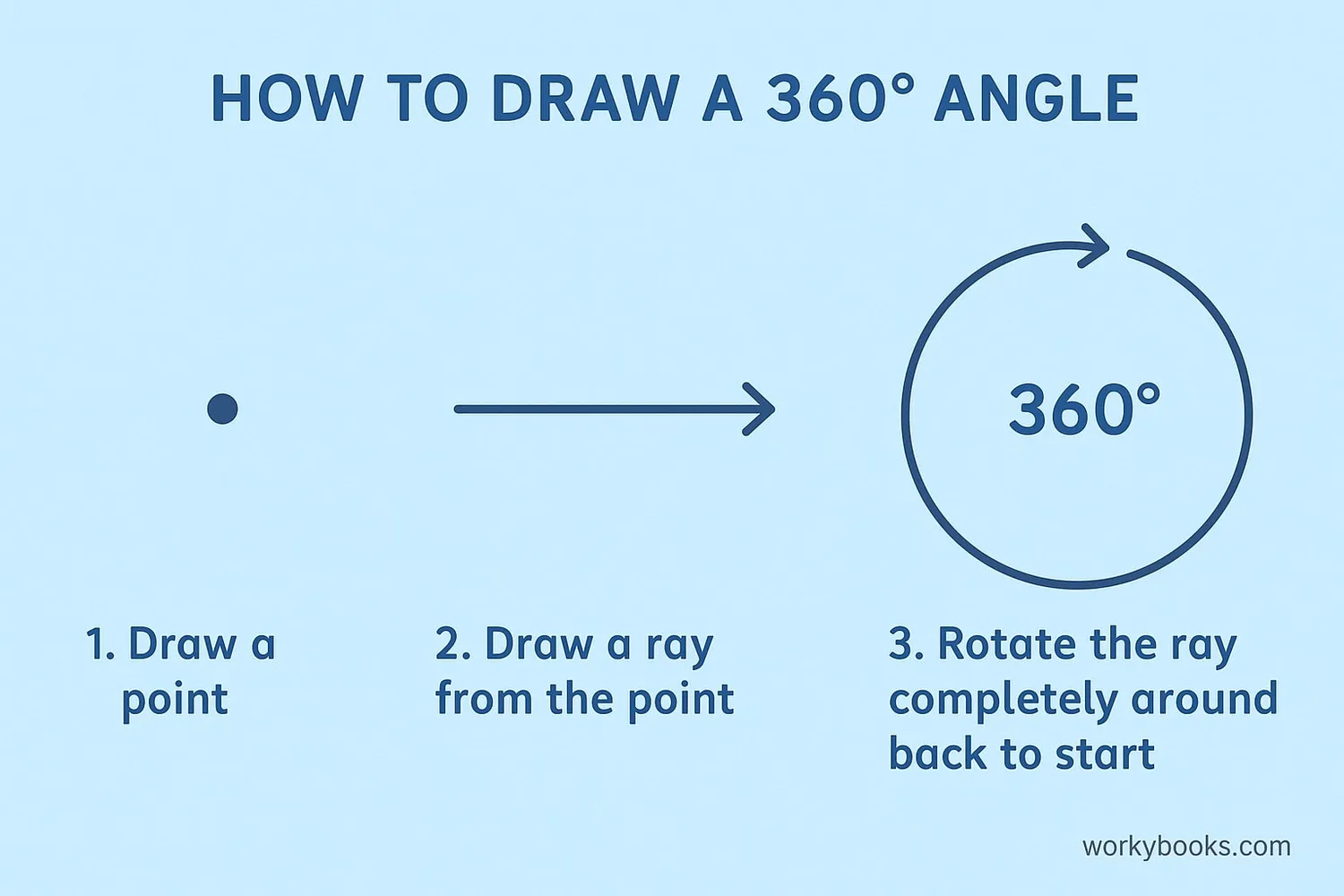360 Degree Angle - Definition, Examples, Quiz, FAQ, Trivia
Understanding the complete angle and full rotation in geometry
What is a 360 Degree Angle?
A 360 degree angle, also called a complete angle or full rotation, is formed when a ray makes a complete circle and returns to its starting position. It represents the entire space around a point.
The name comes from ancient Babylonian astronomers who divided a circle into 360 parts. This system has been used for thousands of years in mathematics, navigation, and timekeeping.
When you turn all the way around to face the same direction again, you've made a 360 degree turn. This is equal to four right angles (90° each) or two straight angles (180° each).
Key Concept
360 degrees = 1 full rotation = 1 complete circle = 4 right angles = 2 straight angles
Facts About 360 Degree Angles

Here are important facts about 360 degree angles:
Alternative Names
Complete angle, full angle, perigon, full rotation
Radians
360° = 2π radians
Fraction of Circle
360° = 1 full circle
Conjugate Angles
360° is conjugate to 0°
Special Properties:
- When you add all angles around a point, they always equal 360°
- A circle is divided into 360 equal parts called degrees
- 360 was chosen because it has many divisors (24 different numbers divide evenly into 360)
- In navigation, compass directions are based on 360° circles
Remember
All angles together around a single point always add up to 360 degrees. This is called the angle sum property of a point.
How to Draw a 360 Degree Angle

Drawing a 360 degree angle is simple! Follow these steps:
Step 1: Draw a point (this will be the vertex of your angle)
Step 2: Draw a straight line starting from this point (this is the initial side)
Step 3: Rotate your pencil around the vertex point until it returns to the starting position
Step 4: Mark the angle with a circular arrow and label it "360°"
Since a 360 degree angle forms a complete circle, you can also draw it using a compass:
Step 1: Place the point of your compass at the vertex
Step 2: Draw a full circle around the point
Step 3: Add an arrow showing the direction of rotation
Step 4: Label it "360°"
Drawing Tip
Use a protractor to verify that your angle measures exactly 360 degrees. Start at 0°, go all the way around, and end back at 0° (which is the same as 360°).
Real-World Examples

360 degree angles and rotations are all around us! Here are some real-world examples:
1. Wheels: When a wheel makes one complete turn, it rotates 360 degrees. This is why we measure distance traveled by counting wheel rotations.
2. Clocks: The minute hand of a clock makes a 360 degree rotation every hour. The hour hand makes a 360 degree rotation every 12 hours.
3. Sports: In figure skating, a "360" means the skater rotates one complete turn in the air. In skateboarding, a "360 flip" is a complete rotation.
4. Navigation: Compasses are divided into 360 degrees. North is 0°/360°, East is 90°, South is 180°, and West is 270°.
5. Games: When you spin in place during a game of Twister or Simon Says, you're making a 360 degree turn.
6. Fans & Windmills: The blades of a fan or windmill make 360 degree rotations as they turn.
Example Tip
Try this: Stand facing north, then turn around completely until you're facing north again. You've just completed a 360 degree turn!
Angle Practice Quiz
Test your understanding of 360 degree angles with this 5-question quiz. Choose the correct answer for each question.
Frequently Asked Questions
Here are answers to common questions about 360 degree angles:
Angle Trivia
Discover interesting facts about angles and measurement:
Ancient Babylonian Angles
The Babylonians developed the 360-degree system around 1800 BCE. They used a base-60 number system, which made 360 (6 × 60) a convenient number for dividing circles.
Alternative Systems
Some mathematicians have proposed a 400-degree circle (called gradians), but it never became popular. The 360-degree system remains the global standard for angle measurement.
Navigation and Space
NASA uses 360-degree navigation for spacecraft orientation. The Mars rovers use this system to precisely position their instruments and solar panels.
Rotational Records
The world record for the most consecutive 360-degree spins on ice skates is 115 rotations, set by Natalia Kanounnikova in 2006. Each spin represents a full 360-degree rotation.


